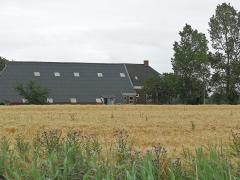Establishing long-term nitrogen response of global cereals to assess sustainable fertilizer rates
Insight into the response of cereal yields to nitrogen fertilizer is fundamental to improving nutrient management and policies to sustain farm economy and food sufficiency with minimum nitrogen pollution. From field data we derive a novel generic function for long-term response of cereal yield and nitrogen pollution to nitrogen input. This function is used to assess sustainable nitrogen inputs for global regions for a wide range of yield potential and income.

While the current use of synthetic nitrogen fertilizer is believed to feed half of the global population it is also the main cause of a doubling of the intensity of the natural global nitrogen cycle and increasing losses of nitrogen to the environment. Finding a balance between the benefits of nitrogen fertilizer use for food production and the impacts of agricultural nitrogen pollution on human health and ecosystems is a challenge in many countries. A pivotal relationship for improving the agronomic and environmental performance of food systems is the long-term response of crop yield to addition of nitrogen fertilizer. We derived such a response function for grain yield and nitrogen surplus of wheat, maize and barley and which is globally applicable. We found long-term optimum nitrogen inputs ranging from 100 to 200 kg nitrogen per hectare in absence of water stress. This function was combined with economic data to quantify the costs and benefits of changes in fertilizer use, and effects on yield and nitrogen pollution, for the purpose of estimating optimum nitrogen inputs from the perspective of farming and society. These rates were found to be lower than current rates for high income regions while higher than current rates for low income regions. The adoption of our proposed long-term sustainable rates may have important implications for the global distribution of cereal production and nitrogen policies in grain producing countries.
Long-term versus short-term yield response of cereals
This response is commonly derived from short-term (1-2 year) field trials, which are used to advice farmers about how much fertilizer to apply next year. However, in these trials soil nitrogen is not in steady state, and the yield response functions are not suitable to project the long-term effect of changing nitrogen regimes on yield and losses to the environment. Long term trials (>10 years) are costly and scarce especially in developing regions. Our long-term response function was first derived from the unique 180 years wheat trial at Rothamsted research UK. This function compared well with a function derived from 25 field long-term experiments with maize, wheat and barley in Europe, Asia and USA, with yields ranging between 2 and 16 t/ha under a wide range of soils and climates.
This work is part of the International Nitrogen Management System project (INMS 2017-2022), funded by the Global Environment Facility (GEF) through the United Nations Environment Programme (UNEP) and in which PBL is one of more than 80 participating international organizations.
Authors
Specifications
- Publication title
- Establishing long-term nitrogen response of global cereals to assess sustainable fertilizer rates
- Publication date
- 31 January 2022
- Publication type
- Article
- Page count
- 11
- Publication language
- English
- Magazine
- Nature Food
- Product number
- 4368




